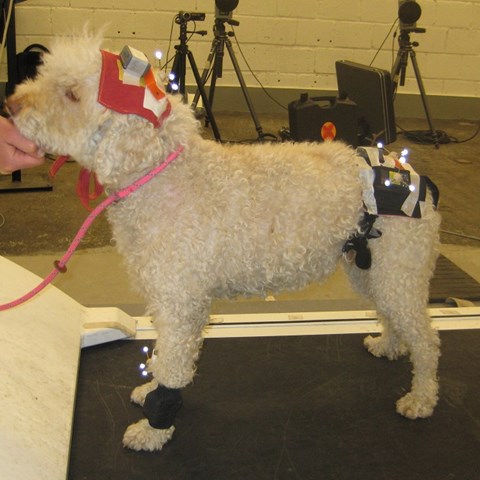Contact
Marie Rhodin
Researcher, Senior Lecturer at the Department of Anatomy, Physiology and Biochemistry (AFB)
Telephone: 018-672194
E-mail: marie.rhodin@slu.se

Lameness detection can be challenging in dogs, as reflected in the reported low inter-rater agreement when visually assessing lameness. The aim of this study was to use an inertial sensor-based system to detect and quantify induced distal and proximal limb disturbances mimicking supporting and swinging limb lameness in dogs trotting on a treadmill by measuring vertical head and pelvic movement symmetry.
Ten clinically sound dogs were equipped with inertial measurement units that were attached to the head, pelvis and right distal forelimb. Vertical head and pelvic movement symmetry were measured while dogs trotted on a treadmill, before and after the induction of moderate support or swinging fore- and hindlimb lameness. Four symmetry variables were calculated: the differences in displacement between the two lowest and between the two highest values of the head and pelvis per stride, respectively. These variables were defined as minimum head difference (HDmin), maximum head difference (HDmax), minimum pelvic difference (PDmin) and maximum pelvic difference (PDmax).
Induction of supporting forelimb and hindlimb lameness produced significant changes in HDmin and PDmin, respectively. Swinging forelimb and hindlimb lameness produced significant changes in HDmax and PDmax, respectively. Additional compensatory ipsilateral forelimb and contralateral hindlimb movements were detected.
Based on our findings, inertial sensor-based systems can be used to detect and quantify induced moderate lameness and differentiate between supporting and swinging limb lameness in dogs trotting on a treadmill. Further studies are needed to evaluate this method in dogs presented for clinical lameness evaluation and in overground locomotion.
http://www.sciencedirect.com/science/article/pii/S109002331730045X
Rhodin M., Bergh. A., Gustås P.and Gómez Álvarez C.B. (2017) Inertial sensors based system for lameness detection in trotting dogs with induced lameness. Veterinary Journal. doi.org/10.1016/j.tvjl.2017.02.004.
Marie Rhodin
Researcher, Senior Lecturer at the Department of Anatomy, Physiology and Biochemistry (AFB)
Telephone: 018-672194
E-mail: marie.rhodin@slu.se